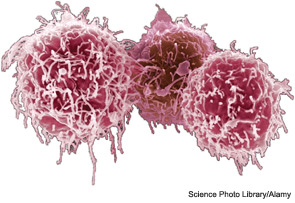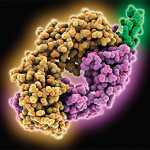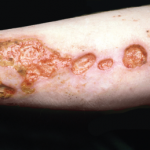
Historically, granulomatosis with polyangiitis (Wegener’s granulomatosis; GPA) and microscopic polyangiitis (MPA) were usually relentlessly progressive and often fatal illnesses. Immunosuppressive therapy has converted these diseases, which are often referred to collectively as antineutrophil cytoplasmic antibody (ANCA)–associated vasculitis (AAV), into chronic conditions in which remission is usually achieved, but subsequent relapse is common and yet unpredictable in its timing.
Because treatment with glucocorticoids combined with either cyclophosphamide, rituximab, or methotrexate leads to remission in the great majority of patients, identifying optimal strategies to maintain remission with minimal toxicity has become nearly as important a research topic as refining remission-induction regimens, and one that is highly relevant to clinical practice. Maintenance regimens have been compared in recent randomized clinical trials, but many unanswered questions remain. I will summarize these trials, highlight the important remaining questions, review the observational data that can be used to address these questions while we await trial results, and conclude with examples of how I use the available data to guide management of different types of patients.
Effects of Remission-Induction Regimen and Other Factors on Relapse Rates
Randomized trials are particularly important for answering questions about remission-maintenance in AAV for three reasons. First, subsets of AAV defined by ANCA specificity have different relapse rates. Multiple studies have indicated that patients with antibodies to myeloperoxidase (MPO) have relapse rates about 50% lower than patients with antibodies to proteinase-3 (PR3).1,2 Second, and not surprisingly, patients who have relapsed in the past are more likely to relapse again. Thus, comparing relapse rates between trials with different percentages of anti–MPO-positive patients and/or of newly diagnosed patients is problematic.
Third, different induction regimens have been found to be associated with different relapse rates in the setting of randomized trials in which induction regimens differed but maintenance regimens were the same in all groups. This finding has been made even in the setting in which the initial effectiveness of the induction regimens appeared to be the same. Thus, initial use of methotrexate or intravenous cyclophosphamide has been associated with higher relapse rates than oral cyclophosphamide.1,3
A recent trial showing that rituximab was equivalent to oral cyclophosphamide for remission-induction (RAVE) may be more difficult to interpret with regard to relapse rates, since the cyclophosphamide group received azathioprine to complete 18 months of standard treatment, whereas the rituximab group did not receive any additional treatment, and it is presumed that the drug’s effect (based on return of circulating B cells) had worn off in nearly all patients by Month 18.4 The key 18-month clinical outcome of RAVE is not yet published but was presented at the 2011 ACR annual meeting: Relapse rates were the same in patients who received one course of rituximab and in patients who continued to receive azathioprine after cyclophosphamide.5 Thus, as of Month 18, either induction therapy with rituximab led to lower subsequent relapse rates than induction with oral cyclophosphamide, or maintenance therapy with azathioprine had little or no benefit.
Key Points
- Both the remission-induction regimen and ANCA specificity (PR3 or MPO) influence future relapse rates.
- Randomized trials of maintenance regimens indicate that azathioprine and methotrexate are equivalent, and superior to mycophenolate.
- Rituximab appears to be highly effective as maintenance therapy, but reports are anecdotal and mostly unpublished.
- Uncertainties that should be addressed in future trials include comparison of rituximab to azathioprine for maintenance, comparison of different durations of maintenance, and measurement of the effect of low-dose prednisone on relapse rates.
The RAVE trial design therefore serves as a reminder that it is worth considering the evidence that maintenance treatment is effective at all. The data addressing this question are limited and mostly observational but, I think, still convincing. First, early in the era of successful treatment of GPA with cyclophosphamide, it was noted that patients treated for only a few months were very likely to relapse, which led to the recommendation to continue cyclophosphamide for a year after achievement of remission.6 Second, addition of sulfamethoxizole-trimethoprim to a variety of other medications during remission was associated with reduced relapse rates in a randomized trial.7 Third, comparison of two groups of patients separated in time but otherwise managed very similarly at one center indicated that relapse rates were much lower in patients given methotrexate rather than sulfamethoxizole-trimethoprim after remission induction.8
Trials: Immune-Suppressive Drugs as Maintenance Therapy
On that background, the current standard of care for maintenance therapy has been established by randomized trials. Most importantly, in a trial now known as CYCAZAREM, the demonstration that switching from cyclophosphamide to azathioprine (2 mg/kg daily) at the time of achieving remission (between Months 3 and 6) resulted in the same relapse rate as continuing cyclophosphamide changed standard of care.9 Incidentally, the fact that this trial was 18 months long has contributed to the widespread practice and recommendation to discontinue maintenance therapy at 18 months in patients who have remained in remission—a strategy that has never been compared to continuing therapy.
More recent trials have shown that relapse rates are similar with the use of azathioprine or methotrexate (25 mg/week orally) and, surprisingly and disappointingly, higher with mycophenolate mofetil (2,000 mg/day) than with azathioprine.10,11 The latter study thereby provided some unintended reassurance that standard maintenance therapy is useful. Leflunomide at 30 mg/day was superior to methotrexate at 20 mg/week for remission maintenance in one small study, but the safety of that dose and, conversely, the efficacy of the more usual dose (20 mg/day) are unknown. Another study found that the addition of etanercept to standard maintenance therapy did not reduce relapse rates.12,13 Thus, azathioprine remains the best choice for patients with significant renal dysfunction or liver disease, methotrexate is an appropriate alternative for all other patients, and either leflunomide or mycophenolate remain options in the event that the other two drugs are contraindicated, poorly tolerated, or ineffective for a given patient. Whether there is a role for high-dose sulfamethoxizole-trimethoprim (one double-strength tablet twice daily) in addition to an immune-suppressive drug continues to be a source of debate, but this drug at this strength should not be used in combination with methotrexate.
National and international collaborations will ensure that the scientific basis for more effective and/or less toxic therapies will continue to expand.
Unanswered Questions in Maintenance Therapy
As mentioned above, the strategy of discontinuing maintenance treatment after 18–24 months is widely followed but somewhat arbitrary. A trial in progress in Europe (REMAIN) compares treatment for 18–24 months versus four years of therapy. Data from this trial on anti–PR3-positive and anti–MPO-positive subsets will also be of interest.
The use of low-dose glucocorticoids (prednisone or prednisolone 5–10 mg/day) as a standard component of maintenance therapy is a source of considerable controversy and varying practice among experts worldwide. Unfortunately, although this question is clearly amenable to a randomized trial, none have been done. As indicated above, comparing relapse rates between trials is problematic, due to different induction regimens, different percentages of anti–MPO-positive patients or newly diagnosed patients, different definitions of remission and relapse, and evaluation by different investigators in different countries. With those substantial caveats, a recent meta-analysis is notable for showing that trials in which glucocorticoids were routinely continued for 12–18 months (mostly European studies) reported markedly lower relapse rates than those in which they were discontinued earlier, usually by Month 6 (including most U.S. studies). None of the other variables that contributed to the heterogeneity of these trials was found to be associated with the relapse rate.14
A final area of great uncertainty is how maintenance therapy should be handled in patients receiving rituximab for induction of remission. Data presented at the 2010 ACR annual meeting but not yet published indicate that many patients treated with rituximab do suffer relapses, and that continuing rituximab treatment either on a scheduled basis (e.g., two 1,000-mg doses every six months) or after return of B cells and/or a rise in ANCA titer leads to low relapse rate.15,16 However, the optimal strategy for retreatment, including both the regimen and the choice of patients, has not been determined, and more importantly, no comparison to standard maintenance drugs, which are much less expensive and probably have lower risks of infection, has been made. A trial in progress in France (MAINRITSAN) compares rituximab to azathioprine for maintenance of remission.
What I Do…
For patients who receive cyclophosphamide for remission-induction, I follow the standard recommendation to switch to azathioprine or methotrexate between Months 3 and 6, continue maintenance to complete 18 months of treatment, then taper off the maintenance drug—in most patients. In the absence of data comparing 18-month to four-year strategies, I think the available data (e.g., see reference 9) suggest that the rate of first relapse accelerates or is unchanged after discontinuation of the maintenance drug at Month 18, rather than approaching a plateau as one would expect if patients with a tendency to relapse “declare themselves” early. Thus, for patients in whom a relapse might be devastating (e.g., due to tenuous renal function or poor tolerance of glucocorticoids), continuing maintenance therapy indefinitely is reasonable. It is also appropriate for patient preference to play a large role in decision making on this issue.
However, I prefer to use rituximab for remission-induction therapy in most ANCA-positive patients, and particularly those who have previously received cyclophosphamide.4 Since there cannot yet be a strong guideline for maintenance therapy in this setting, I interpret the observational data as follows. For a patient with a first episode of AAV associated with anti-MPO antibodies, I do not use any subsequent maintenance drug (other than prednisone, see below). For a patient with a severe relapse, particularly if it occurs on a maintenance drug, I continue rituximab, either 1,000 mg every four months or 1,000 mg twice every six months indefinitely; however, since the community’s experience with such a strategy only extends for three to four years, I am sure that the prospect of discontinuing therapy will arise among patients who do well for several years. For a patient with a first episode of AAV associated with anti-PR3 antibodies, I usually recommend a second course of rituximab six months after the first, then watchful waiting. Although I do not routinely start azathioprine or methotrexate for maintenance four to 12 months after an initial course of rituximab, I expect that some colleagues do.
I also continue prednisone 5 mg/day for a year in most patients, regardless of their induction regimen or ANCA specificity. I stress that expert opinion varies widely on this issue. It is again appropriate to involve the patient in the decision making in light of the uncertainties. Parenthetically, many patients, particularly those with GPA and upper-airway disease, require low or moderate doses of prednisone and other immune-suppressive drugs to keep inflammation in check on a chronic basis; this issue is distinct from “remission maintenance” as I have discussed it.
A final area of controversy in the management of patients with AAV in remission is the value of ANCA titers. A recent meta-analysis of studies of cANCA or anti-PR3 titers (there is much less data on anti-MPO) concluded that a rise in ANCA titer (two- to fourfold, or transition from negative to positive, in different studies) is associated with an approximately twofold increase in risk of flare, and that persistence of ANCA following induction therapy is associated with a smaller increase in risk.17 It is therefore not surprising that there is difference of opinion in how to approach changes in titer clinically. I admit that I am always gratified to see an ANCA titer drop to a normal or very low level after induction therapy and am relieved when it remains there during or after maintenance therapy, but I do not escalate or reinitiate maintenance therapy when a titer rises, nor do I base the choice or duration of maintenance drug(s) on ANCA titers.
Conclusion
Although there remain many uncertainties about the optimal approach(es) to induction and maintenance therapy in AAV, the good news for patients and providers is that multiple options are supported by the available evidence, and that national and international collaborations will ensure that the scientific basis for more effective and/or less toxic therapies will continue to expand.
Dr. Monach is assistant professor in the section of rheumatology and director of the Vasculitis Center at Boston University School of Medicine.
References
- Harper L, Morgan MD, Walsh M, et al. Pulse versus daily oral cyclophosphamide for induction of remission in ANCA-associated vasculitis: Long-term follow-up. Ann Rheum Dis. 2011;71:955-960.
- Pagnoux C, Hogan SL, Chin H, et al. Predictors of treatment resistance and relapse in antineutrophil cytoplasmic antibody-associated small-vessel vasculitis: Comparison of two independent cohorts. Arthritis Rheum. 2008;58:2908-2918.
- De Groot K, Rasmussen N, Bacon PA, et al. Randomized trial of cyclophosphamide versus methotrexate for induction of remission in early systemic antineutrophil cytoplasmic antibody-associated vasculitis. Arthritis Rheum. 2005;52:2461-2469.
- Stone JH, Merkel PA, Spiera R, et al. Rituximab versus cyclophosphamide for ANCA-associated vasculitis. N Engl J Med. 2010;363:221-232.
- Stone JH, Merkel PA, Seo P, et al. Extended follow-up of treatment with rituximab versus cyclophosphamide for remission-induction of ANCA-associated vasculitis: Which subsets are at greatest risk for flare? Arthritis Rheum. 2011;63:S946.
- Hoffman GS. Treatment of Wegener’s granulomatosis: Time to change the standard of care? Arthritis Rheum. 1997;40:2099-2104.
- Stegeman CA, Tervaert JW, de Jong PE, Kallenberg CG. Trimethoprim-sulfamethoxazole (co-trimoxazole) for the prevention of relapses of Wegener’s granulomatosis. Dutch Co-Trimoxazole Wegener Study Group. N Engl J Med. 1996;335:16-20.
- de Groot K, Reinhold-Keller E, Tatsis E, et al. Therapy for the maintenance of remission in sixty-five patients with generalized Wegener’s granulomatosis. Methotrexate versus trimethoprim/sulfamethoxazole. Arthritis Rheum. 1996;39:2052-2061.
- Jayne D, Rasmussen N, Andrassy K, et al. A randomized trial of maintenance therapy for vasculitis associated with antineutrophil cytoplasmic autoantibodies. N Engl J Med. 2003;349:36-44.
- Pagnoux C, Mahr A, Hamidou MA, et al. Azathioprine or methotrexate maintenance for ANCA-associated vasculitis. N Engl J Med. 2008;359:2790-2803.
- Hiemstra TF, Walsh M, Mahr A, et al. Mycophenolate mofetil vs azathioprine for remission maintenance in antineutrophil cytoplasmic antibody-associated vasculitis: A randomized controlled trial. JAMA. 2010;304:2381-2388.
- Metzler C, Miehle N, Manger K, et al. Elevated relapse rate under oral methotrexate versus leflunomide for maintenance of remission in Wegener’s granulomatosis. Rheumatology (Oxford). 2007;46:1087-1091.
- Wegener’s Granulomatosis Etanercept Trial (WGET) Research Group. Etanercept plus standard therapy for Wegener’s granulomatosis. N Engl J Med. 2005;352:351-361.
- Walsh M, Merkel PA, Mahr A, Jayne D. Effects of duration of glucocorticoid therapy on relapse rate in antineutrophil cytoplasmic antibody-associated vasculitis: A meta-analysis. Arthritis Care Res (Hoboken). 2010;62:1166-1173.
- Jones RB, Smith R, Guerry MJ, et al. Protocolized versus non-protocolized rituximab treatment for refractory ANCA-associated vasculitis. Arthritis Rheum. 2010;62:S283.
- Cartin-Ceba R, Golbin J, Keogh KA, et al. Rituximab for remission induction and mainenance in ANCA-associated vasculitis: A single-center ten-year experience in 108 patients. Arthritis Rheum. 2010;62:S283.
- Tomasson G, Grayson PC, Mahr AD, Lavalley M, Merkel PA. Value of ANCA measurements during remission to predict a relapse of ANCA-associated vasculitis—a meta-analysis. Rheumatology (Oxford). 2012;51:100-109.



